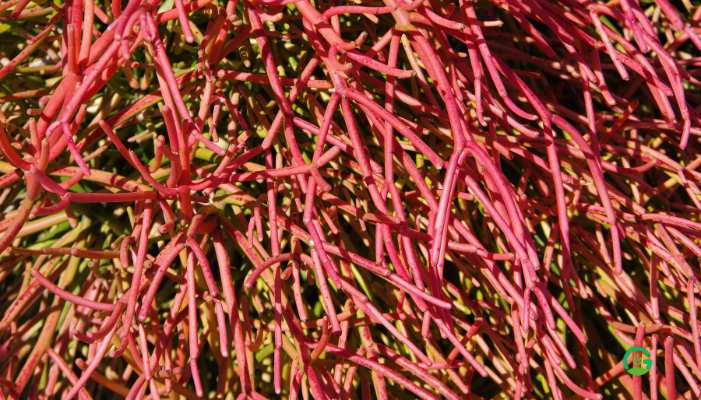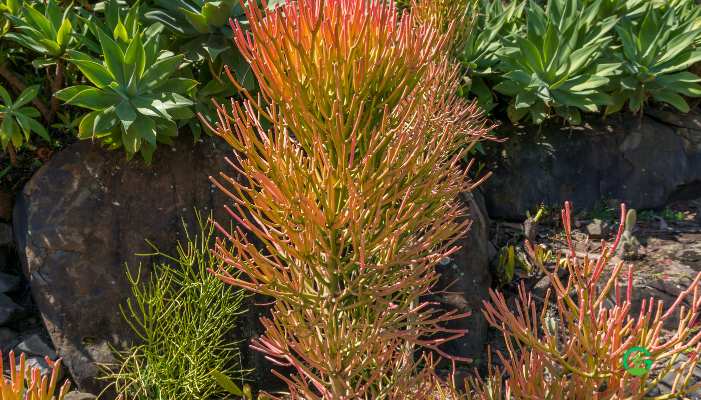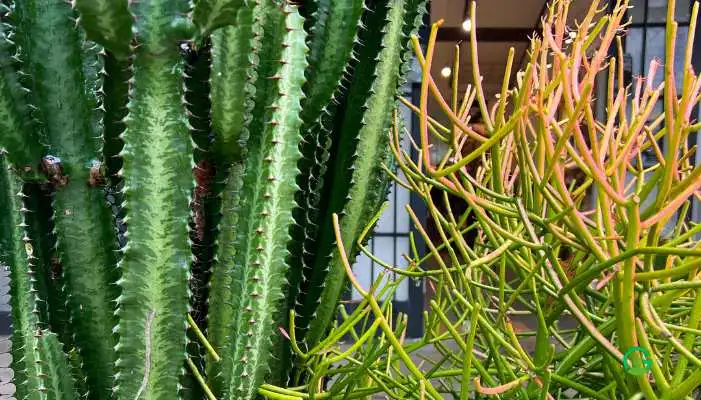Introduction
Have you ever come across a plant that looks like it’s on fire? Meet the firestick cactus, a fascinating and visually striking succulent that adds a pop of color to any space.
Whether you’re an experienced gardener or just starting, this plant is sure to catch your eye and pique your interest.
In this comprehensive guide, we’ll dive deep into everything you need to know about the firestick cactus, from its origins and care tips to its benefits and potential risks. Let’s embark on this journey and explore the fiery beauty of the firestick cactus together!
Firestick Cactus Table of Contents
What is a Firestick Cactus?
The firestick cactus, also known as Euphorbia tirucalli, is a succulent plant that belongs to the Euphorbiaceae family. Despite its name, it’s not a true cactus. This plant is also commonly referred to as the pencil cactus or sticks on fire. Its unique appearance and vibrant colors make it a popular choice for both indoor and outdoor gardens.
Origin and History
The firestick cactus hails from Africa, where it thrives in arid and semi-arid climates. It has been used for centuries by local communities for various purposes, including medicinal and ornamental uses. Over time, it has gained popularity worldwide for its resilience and striking visual appeal.

Physical Characteristics
Appearance
The firestick cactus features slender, cylindrical stems that resemble pencils or sticks, hence its nickname. These stems turn a fiery red, orange, or yellow color in cooler temperatures, creating a stunning display that looks like the plant is on fire.
Size
This plant can grow up to 25 feet tall in its natural habitat, but when grown in containers or as a houseplant, it typically reaches a more manageable height of 3-6 feet.
Flowers
Although the firestick cactus does produce small, inconspicuous flowers, they are not the main attraction. The true beauty of this plant lies in its vibrant stems.
Growing Conditions
Light Requirements
The firestick cactus thrives in bright, direct sunlight. It can tolerate some shade, but for the most vivid colors, place it in a location where it will receive plenty of sunlight.
Temperature and Humidity
This plant prefers warm temperatures and can tolerate high heat. It is not frost-tolerant, so if you live in a colder climate, it’s best to grow it in a container that can be brought indoors during the winter months.
Soil
Well-draining soil is crucial for the firestick cactus. A cactus or succulent potting mix works best. Ensure the soil does not retain excess moisture to prevent root rot.
Planting and Propagation
Planting
When planting a firestick cactus, choose a container with drainage holes to prevent water from sitting at the bottom. Fill the container with a well-draining soil mix and plant the cuttings or young plants at the same depth they were previously growing.
Propagation
The firestick cactus can be easily propagated from cuttings. Simply cut a healthy stem, let it dry for a few days to form a callous, and then plant it in well-draining soil. Water sparingly until roots develop.

Care and Maintenance
Watering
Water the firestick cactus sparingly. Allow the soil to dry out completely between waterings. Overwatering can lead to root rot and other problems.
Fertilizing
During the growing season (spring and summer), you can feed your firestick cactus with a diluted cactus fertilizer once a month. Reduce or stop fertilizing during the fall and winter months.
Pruning
Pruning is not necessary but can help maintain the plant’s shape and size. Always wear gloves when handling the firestick cactus, as its sap can cause skin irritation.
Common Pests and Problems
The firestick cactus is relatively pest-resistant, but it can occasionally be affected by mealybugs or spider mites. Regularly inspect your plant and treat any infestations promptly with insecticidal soap or neem oil.
Root Rot
Overwatering is the most common issue with firestick cactus. Ensure the soil is well-draining and avoid watering too frequently.
Sap Sensitivity
The milky sap of the firestick cactus can cause skin and eye irritation. Always handle with care and wash your hands thoroughly after handling the plant.
Read More
Benefits of Firestick Cactus
Aesthetic Appeal
The firestick cactus adds a dramatic splash of color to any space, making it a popular choice for decorative purposes.
Low Maintenance
This plant is incredibly resilient and requires minimal care, making it perfect for busy individuals or those new to gardening.
Air Purification
Like many succulents, the firestick cactus can help purify the air, contributing to a healthier indoor environment.
Safety Precautions
Handling
Always wear gloves when handling the firestick cactus to avoid skin irritation from the sap. Be cautious when pruning or propagating the plant.
Pets and Children
The firestick cactus is toxic if ingested. Keep it out of reach of pets and small children to prevent accidental ingestion.
Landscaping Ideas
The firestick cactus can be a striking addition to any landscape. Here are a few ideas:
Rock Gardens
Incorporate the firestick cactus into a rock garden for a low-maintenance, visually appealing display.
Borders and Edges
Use the firestick cactus along borders or edges to create a vibrant, colorful outline.
Mixed Succulent Gardens
Combine the firestick cactus with other succulents for a diverse and interesting garden bed.
Image | Product Name | Review | Price |
Firestick Cactus in Containers
Growing the firestick cactus in containers allows for flexibility in placement and easier control over its growing conditions. Choose a pot with good drainage and use a cactus or succulent soil mix. Rotate the pot periodically to ensure even growth.
Seasonal Care Tips
Spring and Summer
During the growing season, water the firestick cactus more frequently and consider feeding it with a diluted cactus fertilizer.
Fall and Winter
Reduce watering in the cooler months and bring container-grown plants indoors if temperatures drop below freezing.
Conclusion
The firestick cactus is a captivating and resilient plant that can brighten up any space with its fiery hues. With minimal care requirements and its striking appearance, it’s an excellent choice for both novice and experienced gardeners. Remember to handle it with care, and you’ll enjoy the vibrant beauty of the firestick cactus for years to come.
Firestick Cactus FAQs
How often should I water my firestick cactus?
Water your firestick cactus sparingly, allowing the soil to dry out completely between waterings. Overwatering can lead to root rot.
Can I grow a firestick cactus indoors?
Yes, the firestick cactus can be grown indoors as long as it receives plenty of bright, direct sunlight. A sunny windowsill is an ideal location.
Is the firestick cactus toxic?
Yes, the firestick cactus is toxic if ingested and its sap can cause skin and eye irritation. Handle with care and keep out of reach of pets and children.
How can I propagate a firestick cactus?
Propagate the firestick cactus by taking cuttings from a healthy stem, letting them dry for a few days to form a callous, and then planting them in well-draining soil.
What should I do if my firestick cactus gets pests?
If your firestick cactus gets pests like mealybugs or spider mites, treat the infestation with insecticidal soap or neem oil. Regularly inspect your plant to catch any issues early.





















1 thought on “How to Grow and Care for Firestick Cactus”